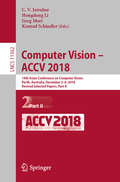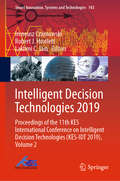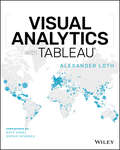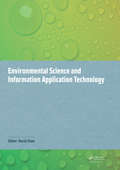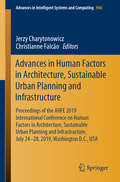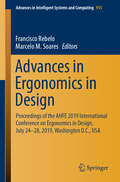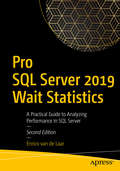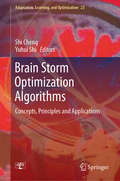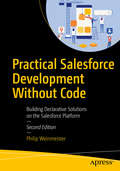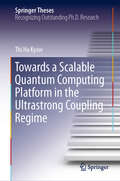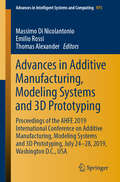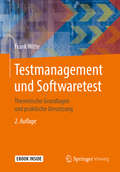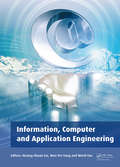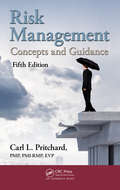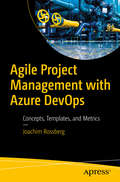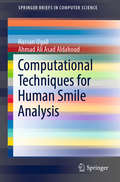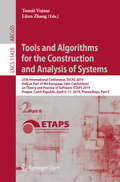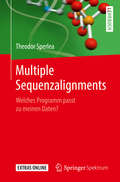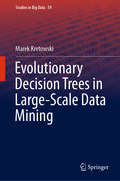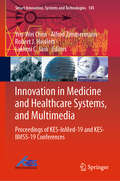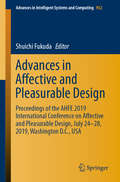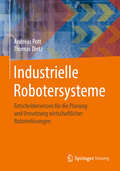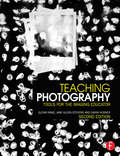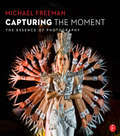- Table View
- List View
Computer Vision – ACCV 2018: 14th Asian Conference on Computer Vision, Perth, Australia, December 2–6, 2018, Revised Selected Papers, Part II (Lecture Notes in Computer Science #11362)
by C. V. Jawahar Hongdong Li Greg Mori Konrad SchindlerThe six volume set LNCS 11361-11366 constitutes the proceedings of the 14th Asian Conference on Computer Vision, ACCV 2018, held in Perth, Australia, in December 2018. The total of 274 contributions was carefully reviewed and selected from 979 submissions during two rounds of reviewing and improvement. The papers focus on motion and tracking, segmentation and grouping, image-based modeling, dep learning, object recognition object recognition, object detection and categorization, vision and language, video analysis and event recognition, face and gesture analysis, statistical methods and learning, performance evaluation, medical image analysis, document analysis, optimization methods, RGBD and depth camera processing, robotic vision, applications of computer vision.
Intelligent Decision Technologies 2019: Proceedings of the 11th KES International Conference on Intelligent Decision Technologies (KES-IDT 2019), Volume 2 (Smart Innovation, Systems and Technologies #143)
by Lakhmi C. Jain Robert J. Howlett Ireneusz CzarnowskiThe book presents a collection of peer-reviewed articles from the 11th KES International Conference on Intelligent Decision Technologies (KES-IDT-19), held Malta on 17–19 June 2019. The conference provided opportunities for the presentation of new research results and discussion about them. It was also an opportunity to generation of new ideas in the field of intelligent decision making. The range of topics explored is wide, and covers methods of classification, prediction, data analysis, decision support, modelling and many more in such areas as finance, cybersecurity, economy, health, management and transportation. The topics cover also problems of data science, signal processing and knowledge engineering.
Visual Analytics with Tableau
by Alexander LothA four-color journey through a complete Tableau visualization Tableau is a popular data visualization tool that’s easy for individual desktop use as well as enterprise. Used by financial analysts, marketers, statisticians, business and sales leadership, and many other job roles to present data visually for easy understanding, it’s no surprise that Tableau is an essential tool in our data-driven economy. Visual Analytics with Tableau is a complete journey in Tableau visualization for a non-technical business user. You can start from zero, connect your first data, and get right into creating and publishing awesome visualizations and insightful dashboards. • Learn the different types of charts you can create • Use aggregation, calculated fields, and parameters • Create insightful maps • Share interactive dashboards Geared toward beginners looking to get their feet wet with Tableau, this book makes it easy and approachable to get started right away.
Environmental Science and Information Application Technology: Proceedings of the 2014 5th International Conference on Environmental Science and Information Application Technology (ESIAT 2014), Hong Kong, November 7-8, 2014
by David ChanEnvironmental Science and Information Application Technology contains selected papers from the 2014 5th International Conference on Environmental Science and Information Application Technology (ESIAT 2014, Hong Kong, 7-8 November 2014). The book covers a wide variety of topics: - Global Environmental Change and Ecosystems Management - Graphic and I
Advances in Human Factors in Architecture, Sustainable Urban Planning and Infrastructure: Proceedings of the AHFE 2019 International Conference on Human Factors in Architecture, Sustainable Urban Planning and Infrastructure, July 24-28, 2019, Washington D.C., USA (Advances in Intelligent Systems and Computing #966)
by Jerzy Charytonowicz Christianne FalcãoThis book discusses human factors research directed towards realizing and assessing sustainability in the built environment and architecture. It reports on advanced engineering methods for sustainable infrastructure design, architecture as well as on assessments of the efficient methods and the social, environmental, and economic impact of various designs and projects. The book covers a range of topics, including the use of recycled materials in architecture, ergonomics in buildings and public design, sustainable design for smart cities, design for the aging population, industrial design, human scale in architecture, and many more. Based on the AHFE 2019 International Conference on Human Factors in Architecture, Sustainable Urban Planning and Infrastructure, held on July 24-28, 2019, in Washington D.C., USA, it offers various perspectives on sustainability and ergonomics. As such, it is a valuable reference resource for designers, urban engineers, architects, infrastructure professionals, public infrastructure owners, policy makers, government engineers and planners, as well as operations managers and academics active in urban and infrastructure research.
Advances in Ergonomics in Design: Proceedings of the AHFE 2019 International Conference on Ergonomics in Design, July 24-28, 2019, Washington D.C., USA (Advances in Intelligent Systems and Computing #955)
by Francisco Rebelo Marcelo M. SoaresThis book provides readers with a timely snapshot of ergonomics research and methods applied to the design, development and prototyping – as well as the evaluation, training and manufacturing – of products, systems and services. Combining theoretical contributions, case studies, and reports on technical interventions, it covers a wide range of topics in ergonomic design including: ecological design; cultural and ethical aspects in design; Interface design, user involvement and human–computer interaction in design; as well as design for accessibility and many others. The book particularly focuses on new technologies such as virtual reality, state-of-the-art methodologies in information design, and human–computer interfaces. Based on the AHFE 2019 International Conference on Ergonomics in Design, held on July 24-28, 2019, Washington D.C., USA, the book offers a timely guide for both researchers and design practitioners, including industrial designers, human–computer interaction and user experience researchers, production engineers and applied psychologists.
Pro SQL Server 2019 Wait Statistics: A Practical Guide to Analyzing Performance in SQL Server
by Enrico van de LaarHere is a practical guide for analyzing and troubleshooting SQL Server performance using wait statistics. Learn to identify precisely why your queries are running slowly. Measure the amount of time consumed by each bottleneck so that you can focus attention on making the largest improvements first. This edition is updated to cover analysis of wait statistics inside Query Store, the CXCONSUMER wait event, and to be current with SQL Server 2019. Whether you are new to wait statistics, or already familiar with them, this book provides a deeper understanding on how wait statistics are generated and what they can mean for your SQL Server instance’s performance. Pro SQL Server 2019 Wait Statistics goes beyond the most common wait types into the more complex and performance-threatening wait types. You’ll learn about per-query wait statistics and session-based wait statistics, and the types of problems they each can help you solve. The different wait types are categorized by their area of impact, including CPU, IO, Lock, and many more.The book presents clear examples to help you gain practical knowledge of why and how specific wait times increase or decrease, and how they impact your SQL Server’s performance. After reading this book you won’t want to be without the valuable information that wait statistics provide regarding where you should be spending your limited tuning time to maximize performance and value to your business. What You'll LearnIdentify resource bottlenecks in a running SQL Server instanceLocate wait statistics information inside DMVs and Query StoreAnalyze the root cause of sub-optimal performanceDiagnose I/O contention and locking contentionBenchmark SQL Server performanceLower the wait time of the most popular wait typesWho This Book Is ForDatabase administrators who want to identify and resolve performance bottlenecks, those who want to learn more about how the SQL Server engine accesses and uses resources inside SQL Server, and administrators concerned with achieving—and knowing they have achieved—optimal performance
Brain Storm Optimization Algorithms: Concepts, Principles and Applications (Adaptation, Learning, and Optimization #23)
by Yuhui Shi Shi ChengBrain Storm Optimization (BSO) algorithms are a new kind of swarm intelligence method, which is based on the collective behavior of human beings, i.e., on the brainstorming process. Since the introduction of BSO algorithms in 2011, many studies on them have been conducted. They not only offer an optimization method, but could also be viewed as a framework of optimization techniques. The process employed in the algorithms could be simplified as a framework with two basic operations: the converging operation and the diverging operation. A “good enough” optimum could be obtained through recursive solution divergence and convergence. The resulting optimization algorithm would naturally have the capability of both convergence and divergence.This book is primarily intended for researchers, engineers, and graduate students with an interest in BSO algorithms and their applications. The chapters cover various aspects of BSO algorithms, and collectively provide broad insights into what these algorithms have to offer. The book is ideally suited as a graduate-level textbook, whereby students may be tasked with the study of the rich variants of BSO algorithms that involves a hands-on implementation to demonstrate the utility and applicability of BSO algorithms in solving optimization problems.
Practical Salesforce Development Without Code: Building Declarative Solutions on the Salesforce Platform
by Philip WeinmeisterUse this hands-on guide to build powerful solutions on the Salesforce platform without using a single line of code. This revised and expanded second edition includes Process Builder, Flow Builder, Lightning App Builder, Lightning Bolt Solutions, and more.Practical Salesforce Development Without Code shows you how to unlock the power of the Salesforce platform to solve real business problems. Adhering to Salesforce's "clicks, not code" mantra, Salesforce expert Phil Weinmeister walks Salesforce newcomers and veterans through different business problems and identifies effective—and proven—approaches to solutions using the platform's declarative framework.By adopting this book as your guide, you will learn how to deliver business solutions within Salesforce by combining analysis, creativity, and logic with core elements such as validation rules, workflow rules, processes, flows, formula fields, and Lightning apps. In addition, Weinmeister dissects and explains the most useful functions and features for declarative developers and shows you how to use them. Best of all, Weinmeister uses real-life business scenarios and visuals. Applying the lessons learned from this how-to guide will ultimately save you time and ensure that your clients or internal customers are enabled, equipped, and empowered. What You'll Learn Build objects, fields, and relationships to establish a sensible data modelAutomate business processes by using Workflow, Process Builder, and FlowUtilize functions and develop formulas effectively for a variety of business needsDevelop approval processes to handle exception scenariosEmploy actions to easily create efficient and relevant user experiencesManage your environments and deploy your solutions Who This Book Is forBusiness analysts, Salesforce administrators, and Salesforce developers
Towards a Scalable Quantum Computing Platform in the Ultrastrong Coupling Regime (Springer Theses)
by Thi Ha KyawThis thesis devotes three introductory chapters to outlining basic recipes for constructing the quantum Hamiltonian of an arbitrary superconducting circuit, starting from classical circuit design. Since a superconducting circuit is one of the most promising platforms for realizing a practical quantum computer, anyone who is starting out in the field will benefit greatly from this introduction. The second focus of the introduction is the ultrastrong light-matter interaction (USC), where the latest developments are described. This is followed by three main research works comprising quantum memory in USC; scaling up the 1D circuit to a 2D lattice configuration; creation of Noisy Intermediate-Scale Quantum era quantum error correction codes and polariton-mediated qubit-qubit interaction. The research work detailed in this thesis will make a major contribution to the development of quantum random access memory, a prerequisite for various quantum machine learning algorithms and applications.
Advances in Additive Manufacturing, Modeling Systems and 3D Prototyping: Proceedings of the AHFE 2019 International Conference on Additive Manufacturing, Modeling Systems and 3D Prototyping, July 24-28, 2019, Washington D.C., USA (Advances in Intelligent Systems and Computing #975)
by Thomas Alexander Massimo Di Nicolantonio Emilio RossiThis book discusses the latest advances in digital modeling systems (DMSs) and additive manufacturing (AM) technologies. It covers applications of networked technologies, ubiquitous computing, new materials and hybrid production systems, discussing how they are changing the processes of conception, modeling and production of products and systems of product. The book emphasizes ergonomic and sustainability issues, as well as timely topics such as DMSs and AM in Industry 4.0, DMSs and AM in developing countries, DMSs and AM in extreme environments, thus highlighting future trends and promising scenarios for further developing those technologies. Based on the AHFE 2019 International Conference on Additive Manufacturing, Modeling Systems and 3D Prototyping, held on July 24-28, 2019, in Washington D.C., USA, the book is intended as source of inspiration for researchers, engineers and stakeholders, and to foster interdisciplinary and international collaborations between them.
Testmanagement und Softwaretest: Theoretische Grundlagen und praktische Umsetzung
by Frank WitteDas Buch gibt konkrete Tipps zur erfolgreichen Umsetzung von Softwaretests und effizientem Testmanagement. Dabei verbindet der Autor theoretische Grundlagen mit betrieblicher Realität zur Anwendung in der Praxis. Er gibt hilfreiche Hinweise, welche Herausforderungen beim Test von Software bestehen, wo es Fallstricke gibt und was zu beachten ist, um sie zu vermeiden.
Information, Computer and Application Engineering: Proceedings of the International Conference on Information Technology and Computer Application Engineering (ITCAE 2014), Hong Kong, China, 10-11 December 2014 (Routledge Revivals)
by Wen-Pei Sung Hsiang-Chuan Liu Wenli YaoThis proceedings volume brings together peer-reviewed papers presented at the International Conference on Information Technology and Computer Application Engineering, held 10-11 December 2014, in Hong Kong, China. Specific topics under consideration include Computational Intelligence, Computer Science and its Applications, Intelligent Information Processing and Knowledge Engineering, Intelligent Networks and Instruments, Multimedia Signal Processing and Analysis, Intelligent Computer-Aided Design Systems and other related topics. This book provides readers a state-of-the-art survey of recent innovations and research worldwide in Information Technology and Computer Application Engineering, in so-doing furthering the development and growth of these research fields, strengthening international academic cooperation and communication, and promoting the fruitful exchange of research ideas. This volume will be of interest to professionals and academics alike, serving as a broad overview of the latest advances in the dynamic field of Information Technology and Computer Application Engineering.
Risk Management: Concepts and Guidance, Fifth Edition
by Carl L. Pritchard, PMP, PMI-RMP, EVPThis new edition of Risk Management: Concepts and Guidance supplies a look at risk in light of current information, yet remains grounded in the history of risk practice. Taking a holistic approach, it examines risk as a blend of environmental, programmatic, and situational concerns. Supplying comprehensive coverage of risk management tools, practices, and protocols, the book presents powerful techniques that can enhance organizational risk identification, assessment, and management—all within the project and program environments.Updated to reflect the Project Management Institute’s A Guide to the Project Management Body of Knowledge (PMBOK® Guide), Fifth Edition, this edition is an ideal resource for those seeking Project Management Professional and Risk Management Professional certification. Emphasizing greater clarity on risk practice, this edition maintains a focus on the ability to apply "planned clairvoyance" to peer into the future. The book begins by analyzing the various systems that can be used to apply risk management. It provides a fundamental introduction to the basics associated with particular techniques, clarifying the essential concepts of risk and how they apply in projects. The second part of the book presents the specific techniques necessary to successfully implement the systems described in Part I. The text addresses project risk management from the project manager’s perspective. It adopts PMI’s perspective that risk is both a threat and an opportunity, and it acknowledges that any effective risk management practice must look at the potential positive events that may befall a project, as well as the negatives.Providing coverage of the concepts that many project management texts ignore, such as the risk response matrix and risk models, the book includes appendices filled with additional reference materials and supporting details that simplifying some of the most complex aspects of risk management.
Il motore ad acqua
by Maria Antonietta Ricagno Ares Van JaagIl motore ad acqua è un’invenzione che sfortunatamente è stata “inventata” molte volte. L'idrogeno proveniente dall'acqua è molto abbondante, è rinnovabile e può essere utilizzato sia nei Paesi con scarse risorse energetiche sia in quelli che ne dispongono in abbondanza. Il petrolio crudo e il gas naturale sono invece risorse energetiche limitate. Ma sono molte le persone che pensano che determinate tecnologie promettenti siano state soppresse da vari poteri politici o economici, generalmente allo scopo di proteggere i loro investimenti e interessi e, ai livelli più estremi e assurdi dell'illogicità cospiroparanoica, per motivazioni sinistre di portata ancora maggiore. In questa nuova opera, il versatile compositore e scrittore Van Jaag ci accompagna in un appassionante viaggio attraverso la storia di questa invenzione sconosciuta e dei suoi denigrati inventori.
Agile Project Management with Azure DevOps: Concepts, Templates, and Metrics
by Joachim RossbergRoll up your sleeves and jump into Agile project management to use and customize Microsoft Azure DevOps. Organizations adopt Agile practices because they are a key enabler to run better projects, get more successful end results, and achieve an overall higher quality output. To benefit the most from Agile, you need an Application Life Cycle Management (ALM) or DevOps toolset that supports your style and work environment. Agile Project Management with Azure DevOps teaches you how to use Azure DevOps to implement many Agile practices such as SAFe, Scrum, and Kanban, and it shows you how they fit into a well-planned Agile implementation. Agile product owners will learn how to work with Azure DevOps to set up a project from scratch, and to continue using Azure DevOps throughout. Keeping track of progress is important in any project. Author Joachim Rossberg teaches you about the tools in Azure DevOps that can help you track progress and key metrics, including those that are available right out of the box. You will learn how to create and refine the backlog, work with Kanban and Scrum task boards, and get exposed to valuable key concepts along the way. Finally, you will dive into Azure DevOps extensibility to learn about the many ways you can customize reporting to best meet your needsWhat You'll LearnUnderstand Agile product management concepts and processes for working with Azure DevOps Discover how Azure DevOps supports agile processes end-to-endImplement Agile processes in Azure DevOpsCustomize Azure DevOps to better support your processesComplete step-by-step setup of an Agile project from scratch and manage it through its life cycleWho This Book Is ForSoftware product owners, Agile leaders, Scrum masters, and software engineers who use Microsoft Azure DevOps. A basic understanding of Agile is helpful.
Computational Techniques for Human Smile Analysis (SpringerBriefs in Computer Science)
by Hassan Ugail Ahmad Ali AldahoudIn this book, the authors discuss the recent developments in computational techniques for automated non-invasive facial emotion detection and analysis with particular focus on the smile. By way of applications, they discuss how genuine and non-genuine smiles can be inferred, how gender is encoded in a smile and how it is possible to use the dynamics of a smile itself as a biometric feature. It is often said that the face is a window to the soul. Bearing a metaphor of this nature in mind, one might find it intriguing to understand, if any, how the physical, behavioural as well as emotional characteristics of a person could be decoded from the face itself. With the increasing deductive power of machine learning techniques, it is becoming plausible to address such questions through the development of appropriate computational frameworks. Though there are as many as over twenty five categories of emotions one could express, regardless of the ethnicity, gender or social class, across humanity, there exist six common emotions – namely happiness, sadness, surprise, fear, anger and disgust - all of which can be inferred from facial expressions. Of these facial expressions, the smile is the most prominent in social interactions. The smile bears important ramifications with beliefs such as it makes one more attractive, less stressful in upsetting situations and employers tending to promote people who smile often. Even pockets of scientific research appear to be forthcoming to validate such beliefs and claims, e.g. the smile intensity observed in photographs positively correlates with longevity, the ability to win a fight and whether a couple would stay married. Thus, it appears that many important personality traits are encoded in the smile itself. Therefore, the deployment of computer based algorithms for studying the human smiles in greater detail is a plausible avenue for which the authors have dedicated the discussions in this book.
Tools and Algorithms for the Construction and Analysis of Systems: 25th International Conference, TACAS 2019, Held as Part of the European Joint Conferences on Theory and Practice of Software, ETAPS 2019, Prague, Czech Republic, April 6–11, 2019, Proceedings, Part II (Lecture Notes in Computer Science #11428)
by Tomáš Vojnar Lijun ZhangThis book is Open Access under a CC BY licence. The LNCS 11427 and 11428 proceedings set constitutes the proceedings of the 25th International Conference on Tools and Algorithms for the Construction and Analysis of Systems, TACAS 2019, which took place in Prague, Czech Republic, in April 2019, held as part of the European Joint Conferences on Theory and Practice of Software, ETAPS 2019. The total of 42 full and 8 short tool demo papers presented in these volumes was carefully reviewed and selected from 164 submissions. The papers are organized in topical sections as follows: Part I: SAT and SMT, SAT solving and theorem proving; verification and analysis; model checking; tool demo; and machine learning. Part II: concurrent and distributed systems; monitoring and runtime verification; hybrid and stochastic systems; synthesis; symbolic verification; and safety and fault-tolerant systems.
Multiple Sequenzalignments: Welches Programm passt zu meinen Daten?
by Theodor SperleaDieses Buch ist ein praktischer Ratgeber für Biologinnen und Biologen, die Multiple Sequenzalignments (MSAs) für ihre Datenanalysen verwenden und einen verständlichen Überblick über die vielen verschiedenen Programme suchen. Trotz ihres wichtigen Stellenwertes in der Datenanalyse herrscht Unsicherheit unter den Forschenden wie MSA-Programme genau funktionieren - ganz zu schweigen davon, wie und warum die unterschiedlichen Analysen zu verschiedenen Ergebnissen führen. Welches Programm ist für die Auswertung meiner Daten das richtige und wie kann ich sicherstellen, alle relevanten Erkenntnisse aus den Alignments gezogen zu haben? Dieses Buch bietet hilfreiche Erklärungen und Hintergründe ohne große bioinformatische Vorkenntnisse vorauszusetzen und führt die Leserinnen und Leser langsam in die Thematik ein.Im ersten Teil des Buches werden die möglichen Einsatzfelder wie auch die Formate, die üblicherweise von MSA-Programmen produziert werden, im Detail beschrieben. Ebenso werden auf unkomplizierte Weise die zentralen Algorithmen sowie die inneren Abläufe der gängigsten MSA-Programme der Vergangenheit und der Gegenwart in größerer Detailtiefe erklärt. Den zweiten Teil des Buches bildet ein ausführlicher datenbasierter Vergleich zwischen MSA-Programmen, der als Entscheidungshilfe für die Programmauswahl für dein nächstes Alignment dienen soll.
Evolutionary Decision Trees in Large-Scale Data Mining (Studies in Big Data #59)
by Marek KretowskiThis book presents a unified framework, based on specialized evolutionary algorithms, for the global induction of various types of classification and regression trees from data. The resulting univariate or oblique trees are significantly smaller than those produced by standard top-down methods, an aspect that is critical for the interpretation of mined patterns by domain analysts. The approach presented here is extremely flexible and can easily be adapted to specific data mining applications, e.g. cost-sensitive model trees for financial data or multi-test trees for gene expression data. The global induction can be efficiently applied to large-scale data without the need for extraordinary resources. With a simple GPU-based acceleration, datasets composed of millions of instances can be mined in minutes. In the event that the size of the datasets makes the fastest memory computing impossible, the Spark-based implementation on computer clusters, which offers impressive fault tolerance and scalability potential, can be applied.
Innovation in Medicine and Healthcare Systems, and Multimedia: Proceedings of KES-InMed-19 and KES-IIMSS-19 Conferences (Smart Innovation, Systems and Technologies #145)
by Lakhmi C. Jain Robert J. Howlett Yen-Wei Chen Alfred ZimmermannThis book contains the proceedings of the KES International conferences on Innovation in Medicine and Healthcare (KES-InMed-19) and Intelligent Interactive Multimedia Systems and Services (KES-IIMSS-19), held on 17–19 June 2019 and co-located in St. Julians, on the island of Malta, as part of the KES Smart Digital Futures 2019 multi-theme conference.The major areas covered by KES-InMed-19 include: Digital IT Architecture in Healthcare; Advanced ICT for Medical and Healthcare; Biomedical Engineering, Trends, Research and Technologies and Healthcare Support System. The major areas covered by KES-IIMSS-19 were: Interactive Technologies; Artificial Intelligence and Data Analytics; Intelligent Services and Architectures and Applications. This book is of use to researchers in these vibrant areas, managers, industrialists and anyone wishing to gain an overview of the latest research in these fields.
Advances in Affective and Pleasurable Design: Proceedings of the AHFE 2019 International Conference on Affective and Pleasurable Design, July 24-28, 2019, Washington D.C., USA (Advances in Intelligent Systems and Computing #952)
by Shuichi FukudaThis book discusses the latest advances in affective and pleasurable design. It reports on important theoretical and practical issues, covering a wealth of topics including aesthetics in product and system design, design-driven innovation, affective computing, evaluation tools for emotion, Kansei engineering for products and services, and many more. Based on papers presented at the AHFE 2019 International Conference on Affective and Pleasurable Design, held on July 24–28, 2019, in Washington DC, USA, the book provides an inspiring guide for all researchers and professionals in the field of design, e.g. industrial designers, emotion designers, ethnographers, human–computer interaction researchers, human factors engineers, interaction designers, mobile product designers, and vehicle system designers.
Industrielle Robotersysteme: Entscheiderwissen für die Planung und Umsetzung wirtschaftlicher Roboterlösungen
by Thomas Dietz Andreas PottDieses Buch bietet eine Einführung in die Grundlagen des industriellen Robotereinsatzes und vermittelt Praxiswissen im Hinblick auf Planung, Umsetzung und Betrieb von Robotersystemen. Roboter haben sich als zuverlässige Werkzeuge in der Automatisierung bewährt. Sie sind in vielen Industriebereichen für die wirtschaftliche Produktion unentbehrlich. Die erweiterten Einsatzmöglichkeiten verursachen allerdings auch einen erheblichen Integrationsbedarf auf dem Weg vom »nackten« Roboter zu einer maßgeschneiderten Roboterlösung. Zur Auswahl der passenden Roboterlösung und zur effektiven Kommunikation mit Lieferanten und Kunden sind technisches Basiswissen, die Grundbegriffe der Robotik und ein umfassender Marktüberblick unverzichtbar. Die Autoren vermitteln praxisnah die notwendigen Grundlagen, um informierte Entscheidungen bei der Umsetzung von Robotersystemen zu treffen.
Teaching Photography: Tools for the Imaging Educator (Photography Educators Series)
by Glenn Rand Garin Horner Jane Alden StevensThe photographic community is rife with talented and creative practitioners and artists. But making great photographs does not always translate into an ability to teach effectively. This new edition of Teaching Photography approaches photographic education from a point of view that stresses the how and why of the education. It includes the resources that will inspire new and seasoned teachers to help students expand their technical and aesthetic abilities and techniques, as well as their visual literacy and the way photography fits into the wider world. Fully updated to include the online/hybrid classroom environment, collaborative learning, rubrics, and using digital technology, plus techniques for inspiring conversations and critiques.
Capturing The Moment: The Essence of Photography
by Michael FreemanThis is not a book about the fundamentals of shutter speed or how your camera works; it is a book that will teach photographers of all levels how to work with their cameras to capture moments whether they are occurring quickly or unfolding over many hours. Capturing the Moment is about a gesture, an expression, a ball in the net, a whale breaching, like Marilyn Monroe’s skirt flying up or Alfred Eisenstaedt’s image of a kiss between a soldier and nurse in Times Square. Moments in all forms are the true core of photography, and this book will explain how to anticipate them, recognise them, choose them, and capture them, through the eyes and wisdom of award-winning photographer and celebrated author Michael Freeman.
